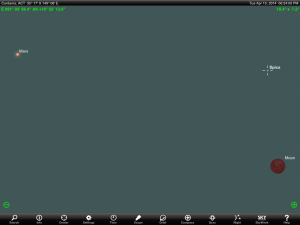Don’t be disappointed tonight (Tuesday 15 April 2014) when the totally eclipsed Moon doesn’t turn out to be literally ‘blood red’ (as apparently outlined in a New York best seller).

The appearance of a lunar eclipse in real life varies dramatically and depends to a large degree on the level of dust in the Earth’s atmosphere. The greater the quantity of dust, the more red and darker the totally eclipsed Moon will be. Dust scatters more of the shorter wavelengths of light leaving the longer (redder) light to be bend into the darkest part of the Earth’s shadow (which is where the Moon will temporarily pass in our evening twilight). I don’t know of anyone who predicts the colour of the Earth’s inner shadow (the umbra) so it is a case of having to wait and see tonight.
| Event times: Tuesday 15 April 2014 Total Lunar Eclipse | Universal Time | Australian Eastern Standard Time |
| Penumbral eclipse begins | 04:52.0 | 2:52 pm AEST |
| Partial eclipse begins | 05:58.0 | 3:58 pm AEST |
| Total eclipse begins | 07:06.4 | 5:06 pm AEST |
| Greatest eclipse | 07:45.7 | 5:46 pm AEST |
| Total eclipse ends | 08:25.0 | 6:25 pm AEST |
| Partial eclipse ends | 09:33.4 | 7:33 pm AEST |
| Penumbral eclipse ends | 10:39.2 | 8:39 pm AEST |
Unfortunately, for Eastern Australia, we won’t be able to get a true idea of the colour of the Earth’s inner shadow (and therefore the eclipsed Moon) as the Moon will be rising in eclipse in the bright evening twilight. This will mask the true colour of the eclipsed Moon. By the time evening twilight has ended, the total eclipse phase will have ended and we will only get to see the dull grey colour of the Earth’s outer shadow on the Moon. Our neighbours in New Zealand will get a much better view as darkness will have fallen their prior to the start of the total eclipse phase and we will have to wait for the images from there to appear on the Internet.
Below: Event times (1) for various Australian cities.
| City | Moon rise | Sunset | Total eclipse phase ends | Nautical dusk
(brightest stars become visible) |
Astronomical dusk
(faint stars visible) |
Partial eclipse phase ends |
| Cairns (Qld) | 6:05.24 pm AEST | 6:08.24 pm AEST | 6:25 pm AEST | 6:55.42 pm AEST | 7:20.55 pm AEST | 7:33 pm AEST |
| Brisbane (Qld) | 5:26.29 pm AEST | 5:31.17 pm AEST | 6:25 pm AEST | 6:22.03 pm AEST | 6:49.08 pm AEST | 7:33 pm AEST |
| Gold Coast (Mermaid Beach, Qld) | 5:24.16 pm AEST | 5:29.10 pm AEST | 6:25 pm AEST | 6:20.11 pm AEST | 6:47.25 pm AEST | 7:33 pm AEST |
| Sydney (NSW) | 5:27.42 pm AEST | 5:32.50 pm AEST | 6:25 pm AEST | 6:27.04 pm AEST | 6:55.58 pm AEST | 7:33 pm AEST |
| Canberra (ACT) | 5:34.43 pm AEST | 5:39.46 pm AEST | 6:25 pm AEST | 6:34.55 pm AEST | 7:04.19 pm AEST | 7:33 pm AEST |
| Melbourne (Vic) | 5:48.57 pm AEST | 5:53.50 pm AEST | 6:25 pm AEST | 6:50.50 pm AEST | 7:21.11 pm AEST | 7:33 pm AEST |
| Hobart (Tas) | 5:32.54 pm AEST | 5:38.39 pm AEST | 6:25 pm AEST | 6:40.06 pm AEST | 7:12.50 pm AEST | 7:33 pm AEST |
| Perth (WA) | 5:55.03 pm AWST | 5:56.02 pm AWST | Not visible – below horizon | Not visible – below horizon | Not visible – below horizon | Not visible – below horizon |
That leaves the mystery of the tetrad (2) mentioned in the aforementioned best seller. I must admit that it is a term I was unfamiliar with. It turns out that it is the term given for a particular pattern of lunar eclipses. This is specifically when four successive total lunar eclipses occur, with no partial lunar eclipses in between and each of which is separated from the other by six lunar months (six full moons). It turns out that astronomically speaking, tetrads are not that uncommon. The last tetrad ended with a total lunar eclipse on 28 October 2004. The current tetrad starts tonight with the last of the four eclipses occurring on 28 September 2015. The next tetrad will start on 25 April 2032.
So sit back and enjoy the show tonight. Also don’t forget that there will be a partial solar eclipse on the afternoon of Tuesday 29 April 2014.
References:
(1) SkySafari Pro
(2) Jean Meeus, Mathematical Astronomical Morsels 111, 2004, Willmann-Bell Inc Publishing.
RT @Nightskyonline: Want to photograph the eclipsed Moon rising this afternoon? Rise times here for various Australian cities: http://t.co/…
RT @Nightskyonline: Want to photograph the eclipsed Moon rising this afternoon? Rise times here for various Australian cities: http://t.co/…
RT @Nightskyonline: Want to photograph the eclipsed Moon rising this afternoon? Rise times here for various Australian cities: http://t.co/…